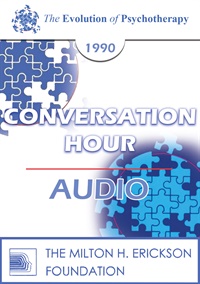
- Average Rating:
- Not yet rated
- Topic Areas:
- Conversation Hours | Psychotherapy
- Categories:
- Evolution of Psychotherapy | Evolution of Psychotherapy 1990
- Faculty:
- Betty Friedan
- Duration:
- 1 Hour 2 Minutes
- Format:
- Audio Only
- Original Program Date:
- Dec 16, 1990
- Short Description:
- Conversation Hour 18 from the Evolution of Psychotherapy 1990, featuring Betty Friedan
- Price:
- $15.00 - Base Price
Tags: Psychotherapy
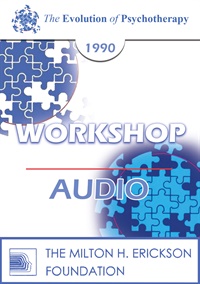
- Average Rating:
- Not yet rated
- Topic Areas:
- Workshops | Group Therapy | Psychotherapy | Redecision Therapy
- Categories:
- Evolution of Psychotherapy | Evolution of Psychotherapy 1990
- Faculty:
- Mary Goulding, MSW
- Duration:
- 2 Hours 32 Minutes
- Format:
- Audio Only
- Original Program Date:
- Dec 16, 1990
- Short Description:
- A therapy group will be formed from Conference participants, in order to demonstrate what can be accomplished in a single group session. Emphasis will be on establishing therapeutic contracts for change and using the past to effect this change. Discussion and whole-group experiences will follow the therapy demonstration.
- Price:
- $15.00 - Base Price
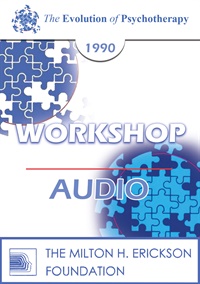
- Average Rating:
- Not yet rated
- Topic Areas:
- Workshops | Reality Therapy | Psychotherapy
- Categories:
- Evolution of Psychotherapy | Evolution of Psychotherapy 1990
- Faculty:
- William Glasser, MD
- Duration:
- 2 Hours 35 Minutes
- Format:
- Audio Only
- Original Program Date:
- Dec 16, 1990
- Short Description:
- This workshop will show, through a series of clinical demonstrations (using attendees from the workshop as role-players), how Reality Therapy works with different types of clients.
- Price:
- $15.00 - Base Price
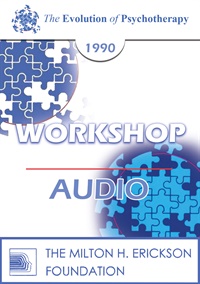
- Average Rating:
- Not yet rated
- Topic Areas:
- Workshops | Bioenergetics | Mind-Body | Psychosomatics | Psychotherapy
- Categories:
- Evolution of Psychotherapy | Evolution of Psychotherapy 1990
- Faculty:
- Alexander Lowen, MD
- Duration:
- 2 Hours 36 Minutes
- Format:
- Audio Only
- Original Program Date:
- Dec 16, 1990
- Short Description:
- This workshop will focus on physical (muscular) tension in the body and relate it to emotional conflicts in the present, derived from early childhood experiences. Specific attention will be paid to temporomandibular tension and to disturbances in breathing. Asthma will be examined as an emotional problem. The dynamics of headaches will be studied, and techniques for releasing underlying tension will be demonstrated.
- Price:
- $15.00 - Base Price
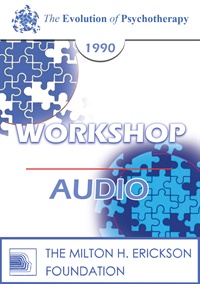
- Average Rating:
- Not yet rated
- Topic Areas:
- Workshops | Ericksonian Hypnosis and Therapy Techniques | Psychotherapy | Tailoring | Utilization | Indirection
- Categories:
- Evolution of Psychotherapy | Evolution of Psychotherapy 1990
- Faculty:
- Jeffrey Zeig, PhD
- Duration:
- 2 Hours 22 Minutes
- Format:
- Audio Only
- Original Program Date:
- Dec 16, 1990
- Short Description:
- Ericksonian approaches use both direct and indirect techniques and tailor methods to the unique characteristics of individual patients. Diagnostic categories can be used to individualize treatment. These tailored techniques are ways of "gift wrapping" ideas so that patients can best actuate effective changes. The concept of "Utilization'' and methods of processing interventions will be discussed. In Ericksonian treatment, dynamic experiences precede dynamic understanding.
- Price:
- $15.00 - Base Price
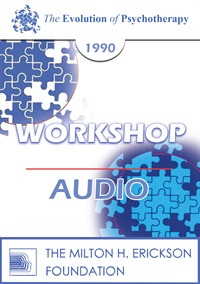
- Average Rating:
- Not yet rated
- Topic Areas:
- Workshops | Children and Adolescent Therapy | Family Therapy | Psychotherapy | Strategic Therapy
- Categories:
- Evolution of Psychotherapy | Evolution of Psychotherapy 1990 | Pioneers in Couples and Family Therapy
- Faculty:
- Jay Haley, MA
- Duration:
- 1 Hour 28 Minutes
- Format:
- Audio Only
- Original Program Date:
- Dec 16, 1990
- Short Description:
- This workshop presents a strategic, problem-focused approach to adolescent therapy, emphasizing family dynamics and the importance of empowering parents. Real cases illustrate how behavioral symptoms shift when family roles and boundaries are addressed. Techniques include structured interventions and culturally sensitive strategies to help parents assert authority and support change.
- Price:
- $15.00 - Base Price
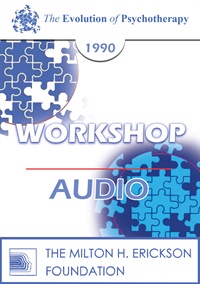
- Average Rating:
- Not yet rated
- Topic Areas:
- Workshops | Family Therapy | Psychotherapy | Children and Adolescent Therapy | Therapist Development
- Categories:
- Evolution of Psychotherapy | Evolution of Psychotherapy 1990 | Pioneers in Couples and Family Therapy
- Faculty:
- Salvador Minuchin, MD
- Duration:
- 1 Hour 36 Minutes
- Format:
- Audio Only
- Original Program Date:
- Dec 16, 1990
- Short Description:
- This workshop explores evolving techniques in family therapy, illustrated through case material. Topics include symbolic symptoms, boundary setting, and multigenerational involvement. A featured case of a young girl with hysterical paralysis underscores how humor, flexibility, and whole-family engagement can foster change—even when full symptom resolution remains elusive.
- Price:
- $15.00 - Base Price
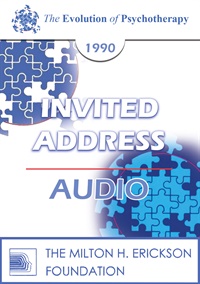
- Average Rating:
- Not yet rated
- Topic Areas:
- Invited Addresses | History of Psychotherapy | Psychotherapy | Therapist Development
- Categories:
- Evolution of Psychotherapy | Evolution of Psychotherapy 1990
- Faculty:
- Rollo May, PhD | James Hillman, PhD
- Duration:
- 1 Hour 6 Minutes
- Format:
- Audio Only
- Original Program Date:
- Dec 16, 1990
- Short Description:
- Epicurus, Kierkegaard, and Nietzsche are forefathers of contemporary psychotherapy. Freud was aware of these wellsprings of modern therapy, and Jung brings them specifically into his writing and his methods. We not only get hints from these forefathers, but we also find a lasting base in them, such as Bubar's "l-thou" construct or Kierkegaard's emphasis on the ultimate relationship of the self to life. These ideas are assumed in Freud, Jung, Adler, Rank, Fromm and other leading therapists in our day. It is these latter therapists who have given us the web of ideas which underlie contemporary psychotherapy.
- Price:
- $15.00 - Base Price
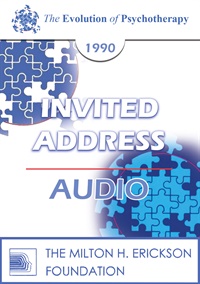
- Average Rating:
- Not yet rated
- Topic Areas:
- Invited Addresses | Psychotherapy | Therapist Development
- Categories:
- Evolution of Psychotherapy | Evolution of Psychotherapy 1990
- Faculty:
- James Bugental, PhD | Erving Polster, PhD
- Duration:
- 1:30:07
- Format:
- Audio Only
- Original Program Date:
- Dec 16, 1990
- Short Description:
- Human experience and human action center in and derive from human subjectivity. Our preoccupation with objectivity results displaces identity from inner living to external. Life-changing psychotherapy requires centered awareness and self-direction. Three therapeutic elements are prime: Full presence, major commitment, and exploring client's self-and-world constructs.
- Price:
- $15.00 - Base Price
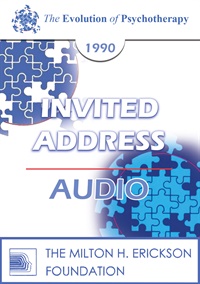
- Average Rating:
- Not yet rated
- Topic Areas:
- Invited Addresses | Borderline | Narcissism | Personality Disorders | Attunement | Therapeutic Relationship | Psychotherapy
- Categories:
- Evolution of Psychotherapy | Evolution of Psychotherapy 1990
- Faculty:
- James F. Masterson, MD | Helen Singer Kaplan, MD, PhD
- Duration:
- 1 Hour 29 Minutes
- Format:
- Audio Only
- Original Program Date:
- Dec 16, 1990
- Short Description:
- The importance of therapeutic alliance is described. Therapeutic alliance, transference, and transference acting-out are defined and distinguished from each other and the therapeutic task of helping the patient to convert transference acting-out to therapeutic alliance and transference is outlined. The differences in the form and content of the intrapsychic structure are described to show why different therapeutic techniques are necessary to establish the therapeutic alliance: Confrontation with the borderline and mirroring interpretation of narcissistic vulnerability with the Narcissistic Personality Disorder. A brief case illustrates each.
- Price:
- $15.00 - Base Price
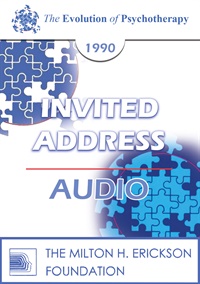
- Average Rating:
- Not yet rated
- Topic Areas:
- Invited Addresses | Psychotherapy | History of Psychotherapy | Transference / Countertransference
- Categories:
- Evolution of Psychotherapy | Evolution of Psychotherapy 1990
- Faculty:
- Judd Marmor | Arnold Lazarus, Ph.D.
- Duration:
- 1 Hour 29 Minutes
- Format:
- Audio Only
- Original Program Date:
- Dec 16, 1990
- Short Description:
- The emphasis in Dynamic Psychotherapy over the past few decades has shifted from a focus on insight and the recovery of early memories to a recognition that the quality of the patient-therapist relationship is the quintessential factor upon which the success of therapy depends. This involves both the real relationship and transference-countertransference elements, all within a systems-theory orientation.
- Price:
- $15.00 - Base Price
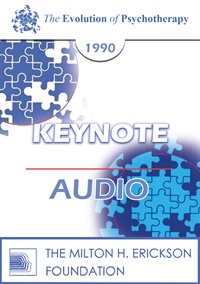
- Average Rating:
- Not yet rated
- Topic Areas:
- Keynotes | Community | Femininity | Gender | Masculinity | Social Issues | Psychotherapy
- Categories:
- Evolution of Psychotherapy | Evolution of Psychotherapy 1990
- Faculty:
- Betty Friedan
- Duration:
- 1 Hour 6 Minutes
- Format:
- Audio Only
- Original Program Date:
- Dec 16, 1990
- Short Description:
- The enormous changes brought about in the last 25 years by the women's movement and the sex role revolution have opened new possibilities and problems-sources of conflict and new strengths for women, men and families. There is a challenge now for psychotherapists to break through their own remnant stereotypes of feminine mystique, masculine mystique, and obsolete assumptions about family so that they may distinguish between personal and political pathology and help evolving women, men and families find and use more consciously their new strengths and confront real problems realistically.
- Price:
- $15.00 - Base Price
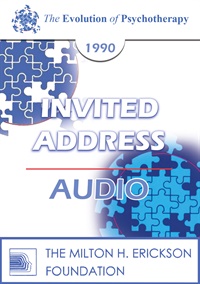
- Average Rating:
- Not yet rated
- Topic Areas:
- Invited Addresses | Couples Therapy | Sex and Sexuality | Interviewing | Therapist Development | Treatment Planning
- Categories:
- Evolution of Psychotherapy | Evolution of Psychotherapy 1990
- Faculty:
- Helen Singer Kaplan, MD, PhD | Joseph Wolpe, M.D.
- Duration:
- 1 Hour
- Format:
- Audio Only
- Original Program Date:
- Dec 15, 1990
- Short Description:
- The evaluation is the single most important clinical task of therapists who work with sexual problems. That is because accurate assessment is the key to successful treatment, and many unnecessary therapy failures can be traced to inadequate evaluation procedures and to the failure of the therapist to elicit pertinent information. Traditional psychological and psychiatric examinations, which emphasize the childhood roots of sexual problems are not adequate for evaluating sexual disorders. Dr. Kaplan will demonstrate her method of evaluation, which focuses on the patient's or couple's current sexual behavior and experience. This, together with historic information, provides the information required for understanding the dynamics of the dysfunction and for formulating a rational treatment plan.
- Price:
- $15.00 - Base Price
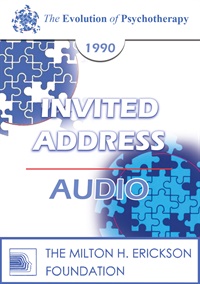
- Average Rating:
- Not yet rated
- Topic Areas:
- Invited Addresses | Addiction | Community | Social Issues | Psychotherapy
- Categories:
- Evolution of Psychotherapy | Evolution of Psychotherapy 1990
- Faculty:
- Thomas Szasz, MD | Rollo May, PhD
- Duration:
- 1 Hour 20 Minutes
- Format:
- Audio Only
- Original Program Date:
- Dec 15, 1990
- Short Description:
- Dr. Szasz will present a brief historical review of drug controls in the United States; a critical analysis of the transformation of the trade in drugs from a free market at the beginning of the century to a tightly statist system of controls today; and a market-oriented analysis of the "drug problem."
- Price:
- $15.00 - Base Price
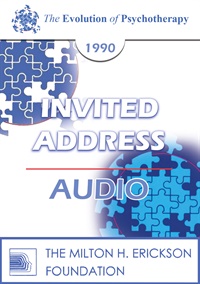
- Average Rating:
- Not yet rated
- Topic Areas:
- Invited Addresses | Consciousness | Psychotherapy | Relationships
- Categories:
- Evolution of Psychotherapy | Evolution of Psychotherapy 1990
- Faculty:
- James Hillman, PhD | Alexander Lowen, MD
- Duration:
- 1 Hour 30 Minutes
- Format:
- Audio Only
- Original Program Date:
- Dec 15, 1990
- Short Description:
- Psyche has been located wholly intrapersonally (within the individual} or interpersonally (between persons, families, groups}, but never is it conceived also extra-personally as a component of the world, as a world soul or anima mundi in the classical sense.
- Price:
- $15.00 - Base Price
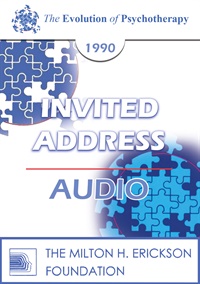
- Average Rating:
- Not yet rated
- Topic Areas:
- Invited Addresses | Gestalt | Psychotherapy | Therapist Development
- Categories:
- Evolution of Psychotherapy | Evolution of Psychotherapy 1990
- Faculty:
- Erving Polster, PhD | Ernest Rossi, PhD
- Duration:
- 1 Hour 24 Minutes
- Format:
- Audio Only
- Original Program Date:
- Dec 15, 1990
- Short Description:
- The concept of the Self has come to imply a consistent cluster of characteristics which are often given fixed and universal attributes, such as the narcissistic self, topdog and underdog, false and true self, etc. This paper will expand the concept to include the versatility and unique aliveness of the individual's many selves and show how these selves help people make sense of their lives. Special attention will be given to broadening the concepts of introjections, transference, and gestalt formation, showing how these may be instrumental in harmonizing alienated selves.
- Price:
- $15.00 - Base Price
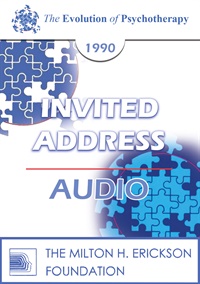
- Average Rating:
- Not yet rated
- Topic Areas:
- Invited Addresses | Femininity | Gender | Psychotherapy
- Categories:
- Evolution of Psychotherapy | Evolution of Psychotherapy 1990
- Faculty:
- Miriam Polster | James Bugental, PhD
- Duration:
- 1 Hour 20 Minutes
- Format:
- Audio Only
- Original Program Date:
- Dec 15, 1990
- Short Description:
- Our present ideals of heroism are dominated by unrealistic and larger-than-life stereotypes. Not only has this narrow view eliminated much of the heroism of women, it has also provided men with simplistic solutions that are not only outmoded, but intimidating. Ultimately, it has deprived both sexes of a wide range of heroic examples and choices that could enrich their lives and the lives of those around them. This paper proposes a redefinition of heroism that expands traditional images and suggests that recognizing the unhackneyed heroism that occurs in ordinary circumstances may also enrich therapeutic possibilities.
- Price:
- $15.00 - Base Price
- Average Rating:
- Not yet rated
- Topic Areas:
- Dialogues | Family Therapy | Psychotherapy
- Categories:
- Evolution of Psychotherapy | Evolution of Psychotherapy 1990 | Pioneers in Couples and Family Therapy
- Faculty:
- Salvador Minuchin, MD | Carl Whitaker, MD
- Course Levels:
- Master Degree or Higher in Health-Related Field
- Duration:
- 58:44
- Format:
- Audio and Video
- Original Program Date:
- Dec 15, 1990
- Short Description:
- Steve Gilligan moderates a discussion between Salvador Minuchin and Carl Whitaker on family therapy, focusing on "terminable" vs. "interminable" therapy. Minuchin describes his long-term, as-needed intervention model, while Whitaker emphasizes transference and the therapist's evolving role. They explore objectivity, time, and the unique dynamics of each family.
- Price:
-
Sale is $29.00
price reduced from Base Price - $59.00
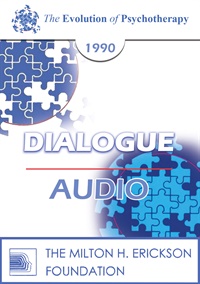
- Average Rating:
- Not yet rated
- Topic Areas:
- Dialogues | Milton Erickson | Psychotherapy | Strategic Therapy
- Categories:
- Evolution of Psychotherapy | Evolution of Psychotherapy 1990 | Pioneers in Couples and Family Therapy
- Faculty:
- Jay Haley, MA | Ernest Rossi, PhD | Jeffrey Zeig, PhD
- Duration:
- 1 Hour 2 Minutes
- Format:
- Audio Only
- Original Program Date:
- Dec 15, 1990
- Short Description:
- This dialogue highlights Milton Erickson’s contributions to therapy, focusing on his use of indirect communication, subtle cues, and analogical thinking. The panelists reflect on his ability to engage patients, elicit cooperation, and access inner resources. Erickson's meticulous methods, field experiments, and personal challenges are also discussed as key influences on his therapeutic style. Moderated by Camillo Loriedo, MD.
- Price:
- $15.00 - Base Price
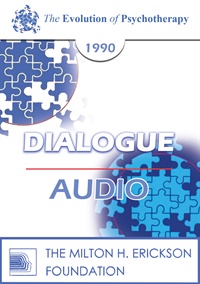
- Average Rating:
- Not yet rated
- Topic Areas:
- Dialogues | Psychotherapy | Therapist Development
- Categories:
- Evolution of Psychotherapy | Evolution of Psychotherapy 1990
- Faculty:
- Rollo May, PhD | Erving Polster, PhD
- Duration:
- 1 Hour 2 Minutes
- Format:
- Audio Only
- Original Program Date:
- Dec 15, 1990
- Short Description:
- Dialogue 09 from the Evolution of Psychotherapy - Growth Facilitation, featuring Rollo May, PhD, and Erving Polster, PhD. Moderated by Betty Alice Erickson-Elliott.
- Price:
- $15.00 - Base Price
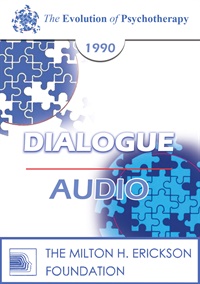
- Average Rating:
- Not yet rated
- Topic Areas:
- Dialogues | Personality Disorders | Psychotherapy | Therapist Development
- Categories:
- Evolution of Psychotherapy | Evolution of Psychotherapy 1990
- Faculty:
- James F. Masterson, MD | Donald Meichenbaum, PhD
- Duration:
- 58 Minutes
- Format:
- Audio Only
- Original Program Date:
- Dec 15, 1990
- Short Description:
- Dialogue 08 from the Evolution of Psychotherapy 1990 - Personality Disorders and Therapeutic Neutrality, featuring James Masterson, MD,and Donald Meichenbaum, PhD. Moderated by Joseph Barber, PhD.
- Price:
- $15.00 - Base Price
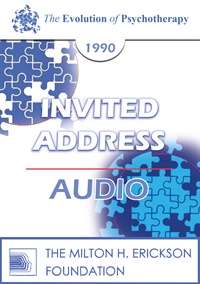
- Average Rating:
- Not yet rated
- Topic Areas:
- Invited Addresses | Reality Therapy | History of Psychotherapy | Psychotherapy
- Categories:
- Evolution of Psychotherapy | Evolution of Psychotherapy 1990
- Faculty:
- William Glasser, MD | Jeffrey Zeig, PhD
- Duration:
- 1 Hour 28 Minutes
- Format:
- Audio Only
- Original Program Date:
- Dec 15, 1990
- Short Description:
- This address includes a brief history of Reality Therapy, and explains that it is based on control theory and that it is applied to both counseling and managing clients. Case examples are used to show that it is composed of two major components: Creating the counseling environment and the procedures that lead to change.
- Price:
- $15.00 - Base Price
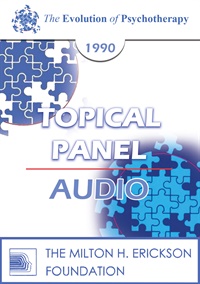
- Average Rating:
- Not yet rated
- Topic Areas:
- Topical Panels | Humor | Psychotherapy | Therapist Development | Strategic Therapy
- Categories:
- Evolution of Psychotherapy | Evolution of Psychotherapy 1990 | Pioneers in Couples and Family Therapy
- Faculty:
- Arnold Lazarus, Ph.D. | Miriam Polster | Carl Whitaker, MD | Cloe Madanes, HDL, LIC
- Duration:
- 58 Minutes
- Format:
- Audio Only
- Original Program Date:
- Dec 15, 1990
- Short Description:
- This panel explores the use of humor as a clinical tool to build connection, reframe challenges, and ease emotional tension. Panelists share strategies for addressing issues such as sexual frustration and financial stress, using humor to strengthen the therapeutic relationship. They discuss the importance of timing, authenticity, and adapting humor to fit each client's needs, especially when working with low-functioning or depressed individuals.
- Price:
- $15.00 - Base Price
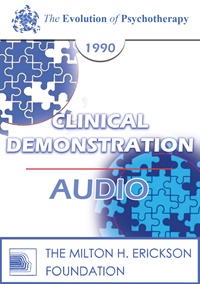
- Average Rating:
- Not yet rated
- Topic Areas:
- Clinical Presentations | Gestalt | Psychotherapy
- Categories:
- Evolution of Psychotherapy | Evolution of Psychotherapy 1990
- Faculty:
- Erving Polster, PhD
- Duration:
- 1 Hour
- Format:
- Audio Only
- Original Program Date:
- Dec 15, 1990
- Short Description:
- Educational Objectives: To learn the power of simple human exchange To learn how experiments may evolve organically
- Price:
- $15.00 - Base Price
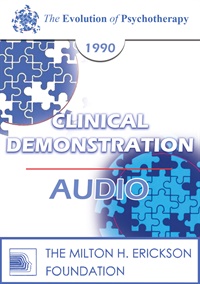
- Average Rating:
- Not yet rated
- Topic Areas:
- Clinical Presentations | Psychotherapy | Therapist Development | Treatment Planning
- Categories:
- Evolution of Psychotherapy | Evolution of Psychotherapy 1990
- Faculty:
- Joseph Wolpe, M.D.
- Duration:
- 52 Minutes
- Format:
- Audio Only
- Original Program Date:
- Dec 15, 1990
- Short Description:
- Educational Objectives: To learn the technique of behavioral data-gathering To understand how data is analyzed to reveal case dynamics and pointers to treatment
- Price:
- $15.00 - Base Price


